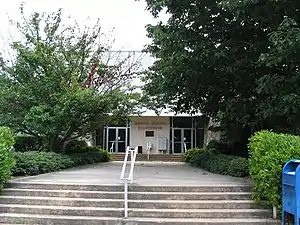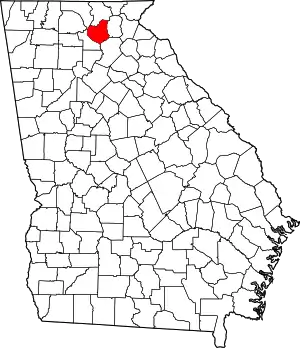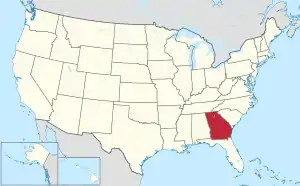Lumpkin County | |
|---|---|
 Lumpkin County Courthouse in Dahlonega | |
 Location within the U.S. state of Georgia | |
 Georgia's location within the U.S. | |
| Coordinates: 34°34′N 84°00′W / 34.57°N 84°W | |
| Country | |
| State | |
| Founded | December 3, 1832 |
| Named for | Wilson Lumpkin |
| Seat | Dahlonega |
| Largest city | Dahlonega |
| Area | |
| • Total | 284 sq mi (740 km2) |
| • Land | 283 sq mi (730 km2) |
| • Water | 1.3 sq mi (3 km2) 0.4% |
| Population (2020) | |
| • Total | 33,488 |
| • Density | 106/sq mi (41/km2) |
| Time zone | UTC−5 (Eastern) |
| • Summer (DST) | UTC−4 (EDT) |
| Congressional district | 9th |
| Website | www |
Lumpkin County is a county located in the north central portion of the U.S. state of Georgia. As of the 2020 census, the population was 33,488.[1] Its county seat is Dahlonega.[2] Lumpkin County is included in the Atlanta-Sandy Springs-Roswell, Georgia Metropolitan Statistical Area.
History
This area was settled by the Cherokee, who also occupied areas of what became delimited as southeastern Tennessee and western North Carolina.
Lumpkin County was created on December 3, 1832.[3] The county was named for Wilson Lumpkin, who at the time was Governor of Georgia.[4] Lumpkin's daughter, Martha Wilson Lumpkin Compton, was the namesake of the town named Marthasville, the early-1840s name for Atlanta in Fulton County; this was designated as the capital of the state after the Civil War.
In the 1830s, gold was discovered in the county near Auraria, leading to a rush of miners and development. The U.S. government established a mint in Dahlonega, operating for 23 years until the outbreak of the American Civil War. State contractors later acquired gold from Lumpkin County to gild the dome of the current state capitol building in Atlanta.
20th century to present
Agriculture and agritourism are top business industries. In addition, vineyards have been developed here and, since the mid-1990s, Lumpkin County has been recognized as "the heart of Georgia wine country." The county features several vineyards and five licensed wineries, which attract many tourists. In 2015, state senator Steve Gooch introduced Georgia Senate Resolution 125, officially recognizing Lumpkin County as the Wine Tasting Room Capital of Georgia.
The historic Dahlonega Square is also a popular destination. It has gift shops, restaurants, art galleries and artists' studios, and additional tasting rooms.
Lumpkin County is the home of the U.S. Army's Camp Frank D. Merrill, the base of the 5th Ranger Training Battalion of the U.S. Army Ranger School's mountain phase. Camp Frank D. Merrill is located in the northern end of the county, within the Blue Ridge Wildlife Management Area of the Chattahoochee National Forest.[5]
Three veterans' organizations are located in Lumpkin County, to serve the veterans and the community: the Heyward Fields American Legion Post 239, the US Army Mountain Ranger Association, and the Lumpkin and White County Veterans of Foreign Wars Post 5533.
Lumpkin County has an agency to help veterans, the Lumpkin County Veterans Affairs Advisory Committee. This group is in charge of the Lumpkin County Veterans Memorial and the twice yearly veterans' memorial crosses, which are installed to line both sides of the major roads in Dahlonega from mid-May through the Fourth of July, and again for the month of November. The crosses are adorned with the names of the county's veterans who have died, some in combat (marked with KIA), and those who returned home and later died.[6]
Geography
According to the U.S. Census Bureau, the county has a total area of 284 square miles (740 km2), of which 283 square miles (730 km2) is land and 1.3 square miles (3.4 km2) (0.4%) is water.[7]
The county is located in the Blue Ridge Mountains. The summit of Blood Mountain, which Lumpkin County shares with Union County to the north, is the highest point in the county. At 4,458 feet (1,359 m), Blood Mountain is the 5th-highest peak in Georgia and the highest point on Georgia's portion of the Appalachian Trail.
The western 40% of Lumpkin County is located in the Etowah River sub-basin of the ACT River Basin (Alabama-Coosa-Tallapoosa River Basin), while the eastern 60% of the county is located in the Upper Chattahoochee River sub-basin of the ACF River Basin (Apalachicola-Chattahoochee-Flint River Basin).[8]
Major highways
Adjacent counties
- Union County – north
- White County – east
- Hall County – southeast
- Dawson County – west
- Fannin County – northwest
National protected area
Demographics
| Census | Pop. | Note | %± |
|---|---|---|---|
| 1840 | 5,671 | — | |
| 1850 | 8,955 | 57.9% | |
| 1860 | 4,626 | −48.3% | |
| 1870 | 5,161 | 11.6% | |
| 1880 | 6,526 | 26.4% | |
| 1890 | 6,867 | 5.2% | |
| 1900 | 7,433 | 8.2% | |
| 1910 | 5,444 | −26.8% | |
| 1920 | 5,240 | −3.7% | |
| 1930 | 4,927 | −6.0% | |
| 1940 | 6,223 | 26.3% | |
| 1950 | 6,574 | 5.6% | |
| 1960 | 7,241 | 10.1% | |
| 1970 | 8,728 | 20.5% | |
| 1980 | 10,762 | 23.3% | |
| 1990 | 14,573 | 35.4% | |
| 2000 | 21,016 | 44.2% | |
| 2010 | 29,966 | 42.6% | |
| 2020 | 33,488 | 11.8% | |
| U.S. Decennial Census[9] 1790-1880[10]1890-1910[11] 1920-1930[12] 1930-1940[13] 1940-1950[14] 1960-1980[15] 1980-2000[16] 2010[1] | |||
2020 census
| Race | Num. | Perc. |
|---|---|---|
| White (non-Hispanic) | 29,241 | 87.32% |
| Black or African American (non-Hispanic) | 412 | 1.23% |
| Native American | 151 | 0.45% |
| Asian | 257 | 0.77% |
| Pacific Islander | 21 | 0.06% |
| Other/Mixed | 1,616 | 4.83% |
| Hispanic or Latino | 1,790 | 5.35% |
As of the 2020 United States census, there were 33,488 people, 11,570 households, and 7,800 families residing in the county.
2010 census
As of the 2010 United States Census, there were 29,966 people, 10,989 households, and 7,645 families living in the county.[18] The population density was 105.9 inhabitants per square mile (40.9/km2). There were 12,925 housing units at an average density of 45.7 per square mile (17.6/km2).[19] The racial makeup of the county was 94.4% white, 1.1% black or African American, 0.6% American Indian, 0.5% Asian, 0.1% Pacific islander, 1.5% from other races, and 1.8% from two or more races. Those of Hispanic or Latino origin made up 4.5% of the population.[18] In terms of ancestry, 17.6% were American, 17.5% were Irish, 15.6% were English, 14.4% were German, and 5.0% were Scotch-Irish.[20]
Of the 10,989 households, 31.1% had children under the age of 18 living with them, 55.3% were married couples living together, 9.6% had a female householder with no husband present, 30.4% were non-families, and 22.2% of all households were made up of individuals. The average household size was 2.56 and the average family size was 3.00. The median age was 36.1 years.[18]
The median income for a household in the county was $43,394 and the median income for a family was $50,318. Males had a median income of $38,043 versus $30,755 for females. The per capita income for the county was $20,088. About 9.2% of families and 15.2% of the population were below the poverty line, including 15.9% of those under age 18 and 11.2% of those age 65 or over.[21]
Development Authority of Lumpkin County
Workforce & Industry
Site Selection
Quality of Life
About Us
Education
Lumpkin County School System manages and operates the public schools. There is one high school (Lumpkin County High School), one middle school (Lumpkin County Middle School), and four elementary schools (Lumpkin County Elementary School, Long Branch Elementary School, Blackburn Elementary School, and Cottrell Elementary). The University of North Georgia has its campus in Lumpkin County.
Politics
| Year | Republican | Democratic | Third party | |||
|---|---|---|---|---|---|---|
| No. | % | No. | % | No. | % | |
| 2020 | 12,163 | 78.24% | 3,126 | 20.11% | 256 | 1.65% |
| 2016 | 9,619 | 76.85% | 2,220 | 17.74% | 678 | 5.42% |
| 2012 | 8,647 | 78.98% | 2,055 | 18.77% | 246 | 2.25% |
| 2008 | 8,326 | 74.95% | 2,586 | 23.28% | 196 | 1.76% |
| 2004 | 6,690 | 75.35% | 2,091 | 23.55% | 97 | 1.09% |
| 2000 | 4,427 | 65.59% | 2,121 | 31.42% | 202 | 2.99% |
| 1996 | 2,576 | 49.86% | 1,949 | 37.73% | 641 | 12.41% |
| 1992 | 1,972 | 39.16% | 2,010 | 39.91% | 1,054 | 20.93% |
| 1988 | 2,688 | 67.20% | 1,286 | 32.15% | 26 | 0.65% |
| 1984 | 1,991 | 64.21% | 1,110 | 35.79% | 0 | 0.00% |
| 1980 | 1,024 | 33.19% | 1,951 | 63.24% | 110 | 3.57% |
| 1976 | 547 | 19.21% | 2,301 | 80.79% | 0 | 0.00% |
| 1972 | 1,477 | 79.32% | 385 | 20.68% | 0 | 0.00% |
| 1968 | 687 | 32.24% | 396 | 18.58% | 1,048 | 49.18% |
| 1964 | 855 | 41.81% | 1,189 | 58.14% | 1 | 0.05% |
| 1960 | 495 | 36.13% | 875 | 63.87% | 0 | 0.00% |
| 1956 | 486 | 41.22% | 693 | 58.78% | 0 | 0.00% |
| 1952 | 370 | 27.07% | 997 | 72.93% | 0 | 0.00% |
| 1948 | 142 | 19.22% | 547 | 74.02% | 50 | 6.77% |
| 1944 | 212 | 19.13% | 896 | 80.87% | 0 | 0.00% |
| 1940 | 165 | 15.46% | 899 | 84.25% | 3 | 0.28% |
| 1936 | 160 | 20.59% | 617 | 79.41% | 0 | 0.00% |
| 1932 | 81 | 8.06% | 924 | 91.94% | 0 | 0.00% |
| 1928 | 381 | 40.49% | 560 | 59.51% | 0 | 0.00% |
| 1924 | 111 | 23.22% | 357 | 74.69% | 10 | 2.09% |
| 1920 | 205 | 56.94% | 155 | 43.06% | 0 | 0.00% |
| 1916 | 55 | 8.08% | 455 | 66.81% | 171 | 25.11% |
| 1912 | 29 | 6.52% | 297 | 66.74% | 119 | 26.74% |
Communities
See also
References
- 1 2 "State & County QuickFacts". United States Census Bureau. Archived from the original on June 7, 2011. Retrieved December 18, 2021.
- ↑ "Find a County". National Association of Counties. Retrieved June 7, 2011.
- ↑ Amerson, Anne Dismukes (1994). "I remember Dahlonega" : Volume 3 memories of growing up in Lumpkin County. Chestatee Publications. OCLC 32506267.
- ↑ State of Georgia (2012). "Lumpkin County". State of Georgia. Retrieved May 29, 2012.
- ↑ "› Organizations › 5th RTBn Home". Archived from the original on April 19, 2012. Retrieved March 19, 2020.
- ↑ "Lumpkincountyveteransadvisory.com". Archived from the original on January 15, 2012. Retrieved February 12, 2013.
- ↑ "US Gazetteer files: 2010, 2000, and 1990". United States Census Bureau. February 12, 2011. Retrieved April 23, 2011.
- ↑ "Georgia Soil and Water Conservation Commission Interactive Mapping Experience". Georgia Soil and Water Conservation Commission. Retrieved November 19, 2015.
- ↑ "Decennial Census of Population and Housing by Decades". US Census Bureau.
- ↑ "1880 Census Population by Counties 1790-1800" (PDF). US Census Bureau. 1880.
- ↑ "1910 Census of Population - Georgia" (PDF). US Census Bureau. 1910.
- ↑ "1930 Census of Population - Georgia" (PDF). US Census Bureau. 1930.
- ↑ "1940 Census of Population - Georgia" (PDF). US Census Bureau. 1940.
- ↑ "1950 Census of Population - Georgia -" (PDF). US Census Bureau. 1950.
- ↑ "1980 Census of Population - Number of Inhabitants - Georgia" (PDF). US Census Bureau. 1980.
- ↑ "2000 Census of Population - Population and Housing Unit Counts - Georgia" (PDF). US Census Bureau. 2000.
- ↑ "Explore Census Data". data.census.gov. Retrieved December 14, 2021.
- 1 2 3 "DP-1 Profile of General Population and Housing Characteristics: 2010 Demographic Profile Data". United States Census Bureau. Archived from the original on February 13, 2020. Retrieved December 30, 2015.
- ↑ "Population, Housing Units, Area, and Density: 2010 - County". United States Census Bureau. Archived from the original on February 13, 2020. Retrieved December 30, 2015.
- ↑ "DP02 SELECTED SOCIAL CHARACTERISTICS IN THE UNITED STATES – 2006-2010 American Community Survey 5-Year Estimates". United States Census Bureau. Archived from the original on February 13, 2020. Retrieved December 30, 2015.
- ↑ "DP03 SELECTED ECONOMIC CHARACTERISTICS – 2006-2010 American Community Survey 5-Year Estimates". United States Census Bureau. Archived from the original on February 13, 2020. Retrieved December 30, 2015.
- ↑ Leip, David. "Dave Leip's Atlas of U.S. Presidential Elections". uselectionatlas.org. Retrieved March 21, 2018.